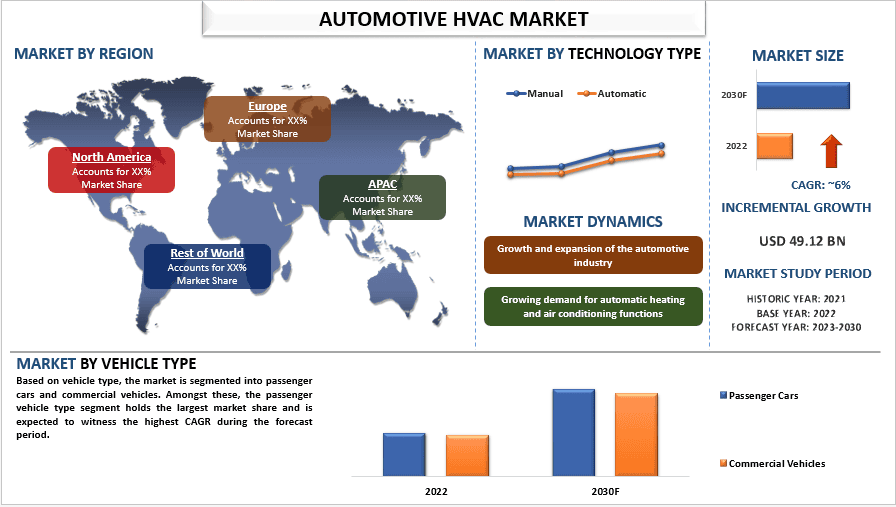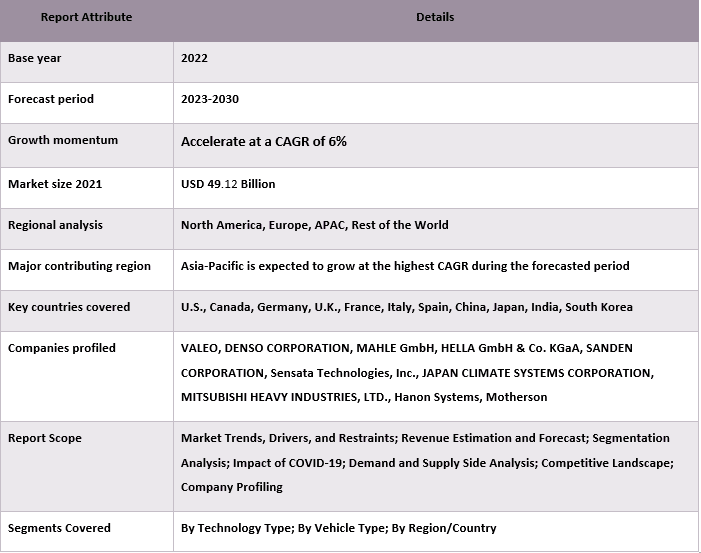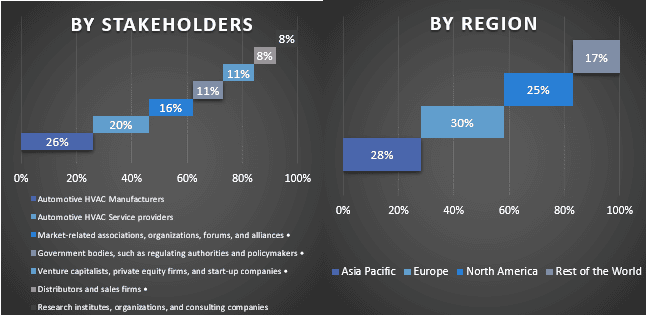- Accueil
- À propos de nous
- Industrie
- Services
- Lecture
- Contactez-nous
Marché de la climatisation automobile : Analyse actuelle et prévisions (2023-2030)
Accent mis sur le type de technologie (manuel, automatique) ; le type de véhicule (voitures particulières, véhicules utilitaires) ; et la région/le pays

Le marché du CVC automobile était évalué à 49,12 milliards de dollars US en 2022 et devrait croître à un TCAC de 6 % de 2022 à 2030 en raison de l'augmentation de la production de véhicules ainsi que de la demande accrue de systèmes thermiques et de fonctions de climatisation automatique dans l'automobile. De plus, le marché du CVC automobile se développe en raison de la forte demande de réfrigérants et de liquides de refroidissement écologiques. Par exemple, en novembre 2021, la société Marelli a mis au point un système de filtration de la qualité de l'air intérieur (QAI) qui tue les bactéries et les virus dans les véhicules et les environnements intérieurs. Ce système utilise la lumière UV-A et UV-C en combinaison avec un filtre au dioxyde de titane (TiO2) pour tuer les bactéries et les virus en suspension dans l'air, y compris le COVID-19, avec une efficacité supérieure à 99 en 15 minutes. Les acteurs du marché s'engagent dans des fusions et acquisitions pour étendre leur présence sur le marché. Par exemple, en 2016, Denso s'est associé à Toyota pour développer Prius, une technologie hybride qui promeut la sécurité, l'efficacité énergétique et la technologie verte dans les véhicules. De plus, les préoccupations croissantes concernant le réchauffement climatique ont légèrement affecté le marché du CVC automobile. En conséquence, de nombreux pays à travers le monde ont commencé à prendre des mesures pour réduire leur empreinte carbone, ce qui pourrait réduire la demande de CVC dans ce segment.
VALEO, DENSO CORPORATION, MAHLE GmbH, HELLA GmbH & Co. KGaA, SANDEN CORPORATION, Sensata Technologies, Inc., JAPAN CLIMATE SYSTEMS CORPORATION, MITSUBISHI HEAVY INDUSTRIES, LTD., Hanon Systems et Motherson figurent parmi les principaux acteurs du marché. Plusieurs fusions et acquisitions ainsi que des partenariats ont été entrepris par ces acteurs pour faciliter l'accès des clients à des produits/technologies innovants et de haute technologie.
Aperçus présentés dans le rapport
« Parmi les types de technologie, le segment automatique devrait croître à un TCAC important au cours de la période de prévision (2023-2030) »
Selon le type de technologie, le marché est segmenté en type de technologie et type de véhicule. Parmi ceux-ci, le segment automatique devrait croître à un TCAC important au cours de la période de prévision (2023-2030). Cela peut être attribué à la demande croissante de systèmes de CVC automobiles automatisés, y compris l'évolution des goûts des clients et la popularité croissante des véhicules haut de gamme.
« Parmi les types de véhicules, les voitures particulières détenaient une part importante du marché en 2022. »
Par type de véhicule, le marché est segmenté en voitures particulières et véhicules utilitaires. Les voitures particulières détenaient une part importante du marché en 2022. Les facteurs résultant de l'augmentation du revenu disponible et de la disponibilité de divers programmes financiers stimulent la demande pour ce segment. En 2021, les ventes mondiales d'automobiles étaient d'environ 66,7 millions d'unités, contre 63,8 millions d'unités en 2020. En raison de ces ventes de véhicules, le service OEM actuel comprend des systèmes de climatisation et un CVC intégré avancé dans les modèles proposés. Par exemple, en octobre 2022, Polestar a lancé trois de ses modèles de VUS électriques sur le marché mondial. Le VUS est équipé d'un système de climatisation avancé pour assurer le confort des passagers lors de longs trajets.
« L'Asie-Pacifique a connu une croissance importante »
Le marché du CVC automobile a connu une croissance importante et une performance bénéfique dans la région Asie-Pacifique, la région à la croissance la plus rapide au monde. En raison de la proximité des principaux constructeurs automobiles, de la forte production d'automobiles et de la demande croissante de véhicules dans les pays qui les produisent, comme la Chine, la Corée et l'Inde, le marché du CVC automobile en Asie-Pacifique est sûr de connaître une croissance importante. Les initiatives gouvernementales visent à stimuler le marché du CVC automobile l'année prochaine pour relancer l'industrie automobile. Par exemple, le gouvernement indien encourage les investissements étrangers en offrant des cours dans l'industrie automobile pour commercialiser les découvertes. La production chinoise de voitures particulières a atteint 996 000 unités en avril 2022, tandis que les ventes se sont établies à 965 000 unités. Cela explique la baisse de la production et des ventes de 41,9 % et 43,4 % en glissement annuel, respectivement. De janvier à avril 2022, la production de voitures particulières a chuté de 2,6 % en glissement annuel, atteignant un total de 6,494 millions d'unités.
Couverture du rapport sur le marché du CVC automobile

Raisons d'acheter ce rapport :
- L'étude comprend une analyse de la taille du marché et des prévisions validée par des experts clés authentifiés de l'industrie.
- Le rapport présente un aperçu rapide de la performance globale de l'industrie en un coup d'œil.
- Le rapport couvre une analyse approfondie des principaux pairs de l'industrie en mettant l'accent sur les principales données financières de l'entreprise, les portefeuilles de produits, les stratégies d'expansion et les développements récents.
- Examen détaillé des moteurs, des contraintes, des tendances clés et des opportunités qui prévalent dans l'industrie.
- L'étude couvre de manière exhaustive le marché à travers différents segments.
- Analyse approfondie au niveau régional de l'industrie.
Options de personnalisation :
Le marché mondial du CVC automobile peut être davantage personnalisé selon les besoins ou tout autre segment de marché. En outre, UMI comprend que vous pouvez avoir vos propres besoins commerciaux, alors n'hésitez pas à communiquer avec nous pour obtenir un rapport qui répond parfaitement à vos exigences.
Table des matières
Méthodologie de recherche pour l'analyse du marché du CVC automobile (2023-2030)
L'analyse du marché historique, l'estimation du marché actuel et la prévision du marché futur du marché mondial du CVC automobile ont été les trois principales étapes entreprises pour créer et analyser l'adoption du CVC automobile dans les principales régions du monde. Une recherche secondaire exhaustive a été menée pour collecter les chiffres du marché historique et estimer la taille actuelle du marché. Deuxièmement, pour valider ces informations, de nombreuses conclusions et hypothèses ont été prises en considération. De plus, des entretiens primaires exhaustifs ont également été menés avec des experts de l'industrie tout au long de la chaîne de valeur du marché mondial du CVC automobile. Après la formulation d'hypothèses et la validation des chiffres du marché par le biais d'entretiens primaires, nous avons utilisé une approche descendante/ascendante pour prévoir la taille complète du marché. Par la suite, des méthodes de ventilation du marché et de triangulation des données ont été adoptées pour estimer et analyser la taille du marché des segments et sous-segments de l'industrie concernée. La méthodologie détaillée est expliquée ci-dessous :
Analyse de la taille historique du marché
Étape 1 : Étude approfondie des sources secondaires :
Une étude secondaire détaillée a été menée pour obtenir la taille historique du marché du CVC automobile à partir de sources internes à l'entreprise telles que les rapports annuels et les états financiers, les présentations de performance, les communiqués de presse, etc., et de sources externes, notamment les revues, les actualités et les articles, les publications gouvernementales, les publications des concurrents, les rapports sectoriels, les bases de données tierces et d'autres publications crédibles.
Étape 2 : Segmentation du marché :
Après avoir obtenu la taille historique du marché du CVC automobile, nous avons mené une analyse secondaire détaillée pour recueillir des informations sur le marché historique et le partager pour différents segments et sous-segments pour les principales régions. Les principaux segments inclus dans le rapport sont le type de technologie et le type de véhicule. Des analyses plus poussées au niveau des pays ont été menées pour évaluer l'adoption globale des modèles de test dans cette région.
Étape 3 : Analyse des facteurs :
Après avoir acquis la taille historique du marché des différents segments et sous-segments, nous avons mené une analyse des facteurs détaillée pour estimer la taille actuelle du marché du CVC automobile. De plus, nous avons mené une analyse des facteurs à l'aide de variables dépendantes et indépendantes telles que le type de technologie et le type de véhicule du marché du CVC automobile. Une analyse approfondie a été menée pour les scénarios de demande et d'offre en tenant compte des principaux partenariats, fusions et acquisitions, de l'expansion des activités et des lancements de produits dans le secteur du marché du CVC automobile à travers le monde.
Estimation et prévision de la taille actuelle du marché
Détermination de la taille actuelle du marché : sur la base des informations exploitables issues des 3 étapes ci-dessus, nous sommes parvenus à la taille actuelle du marché, aux principaux acteurs du marché mondial du CVC automobile et aux parts de marché des segments. Tous les pourcentages de parts requis et les ventilations du marché ont été déterminés à l'aide de l'approche secondaire susmentionnée et ont été vérifiés par le biais d'entretiens primaires.
Estimation et prévision : pour l'estimation et la prévision du marché, des pondérations ont été attribuées à différents facteurs, notamment les moteurs et les tendances, les contraintes et les opportunités offertes aux parties prenantes. Après avoir analysé ces facteurs, les techniques de prévision pertinentes, à savoir l'approche descendante/ascendante, ont été appliquées pour parvenir à la prévision du marché pour 2028 pour différents segments et sous-segments sur les principaux marchés mondiaux. La méthodologie de recherche adoptée pour estimer la taille du marché comprend :
- La taille du marché de l'industrie, en termes de revenus (USD) et le taux d'adoption du marché du CVC automobile sur les principaux marchés nationaux
- Tous les pourcentages de parts, les divisions et les ventilations des segments et sous-segments de marché
- Principaux acteurs du marché mondial du CVC automobile en termes de produits offerts. Également, les stratégies de croissance adoptées par ces acteurs pour être compétitifs sur le marché en croissance rapide
Validation de la taille et de la part du marché
Recherche primaire : des entretiens approfondis ont été menés avec les principaux leaders d'opinion (KOL), notamment les cadres supérieurs (PDG/vice-présidents, chefs des ventes, chefs du marketing, chefs des opérations, chefs régionaux, chefs de pays, etc.) dans les principales régions. Les résultats de la recherche primaire ont ensuite été résumés et une analyse statistique a été effectuée pour prouver l'hypothèse énoncée. Les informations issues de la recherche primaire ont été consolidées avec les résultats secondaires, transformant ainsi les informations en connaissances exploitables.
Répartition des participants primaires dans différentes régions

Ingénierie du marché
La technique de triangulation des données a été utilisée pour compléter l'estimation globale du marché et pour parvenir à des chiffres statistiques précis pour chaque segment et sous-segment du marché mondial du CVC automobile. Les données ont été divisées en plusieurs segments et sous-segments après avoir étudié divers paramètres et tendances dans les domaines du type de technologie et du type de véhicule sur le marché mondial du CVC automobile.
L'objectif principal de l'étude du marché mondial du CVC automobile
Les tendances actuelles et futures du marché mondial du CVC automobile ont été mises en évidence dans l'étude. Les investisseurs peuvent obtenir des informations stratégiques pour fonder leur pouvoir discrétionnaire en matière d'investissements sur l'analyse qualitative et quantitative effectuée dans l'étude. Les tendances actuelles et futures du marché ont déterminé l'attractivité globale du marché au niveau régional, offrant une plateforme aux participants industriels pour exploiter le marché inexploité afin de bénéficier d'un avantage de premier entrant. Les autres objectifs quantitatifs des études comprennent :
- Analyser la taille actuelle et prévisionnelle du marché du CVC automobile en termes de valeur (USD). Également, analyser la taille actuelle et prévisionnelle du marché des différents segments et sous-segments
- Les segments de l'étude comprennent les domaines du type de technologie et du type de véhicule
- Définir et analyser le cadre réglementaire de l'industrie du CVC automobile
- Analyser la chaîne de valeur impliquée avec la présence de divers intermédiaires, ainsi qu'analyser les comportements des clients et des concurrents de l'industrie
- Analyser la taille actuelle et prévisionnelle du marché du CVC automobile pour la région principale
- Les principaux pays des régions étudiées dans le rapport comprennent l'Asie-Pacifique, l'Europe, l'Amérique du Nord et le reste du monde
- Profils d'entreprise du marché du CVC automobile et stratégies de croissance adoptées par les acteurs du marché pour se maintenir sur le marché en croissance rapide
- Analyse approfondie au niveau régional de l'industrie
Connexes Rapports
Les clients qui ont acheté cet article ont également acheté










